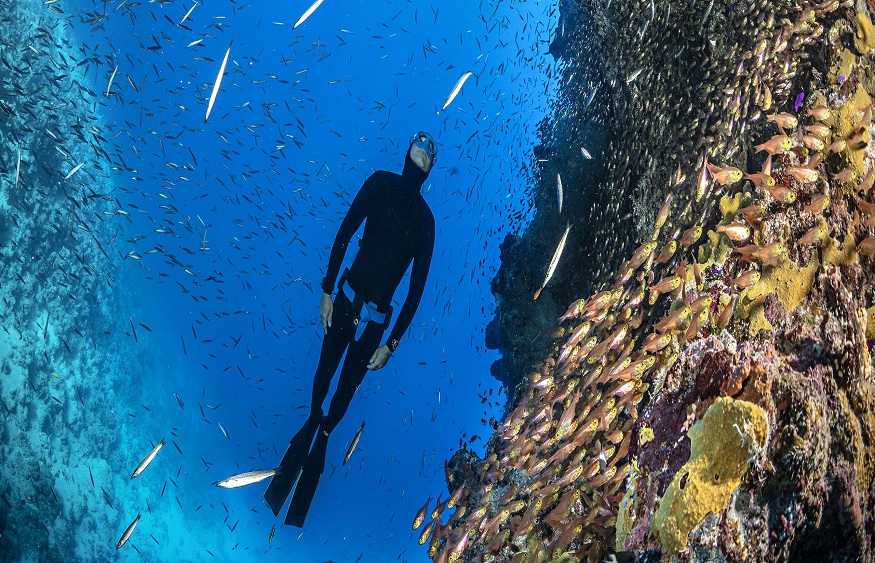Static apnea training stands as a vital tool for freedivers striving to enhance their breath-holding prowess. In this unique training approach, freedivers gracefully float on the water’s surface, attempting to hold their breath for as long as possible, all while staying perfectly still. The primary aim is to cultivate an innate stillness and calmness while progressively extending breath-holding durations.
What Freedrivers Learn from Static Apnea?
Freedivers embarking on static apnea training typically commence with brief breath-holding sessions, gradually extending the duration as they become more comfortable and confident. This training can be conducted in either a controlled aquatic environment, like a pool, or on dry land. When in the water, divers often float face-down on the surface, donning a wetsuit for thermal protection, buoyancy support, and to remain warm. In dry settings, the freediver may choose to sit comfortably or adopt a slightly prone position, avoiding being entirely flat.
However, the advantages of static apnea training extend duration of breath hold. Here’s what freedivers can gain from this unique practice:
1. Mental Preparation for Deeper Dives
Static apnea serves as an effective mental training ground for freedivers preparing to embark on deeper and more challenging underwater excursions. It imparts invaluable skills in relaxation and breath control while submerged, contributing to enhanced overall diving experiences.
Strengthening Diaphragm and Lung Flexibility
Static apnea enhances the flexibility of the diaphragm and lungs, providing freedivers with a powerful edge in breath-holding, lung capacity, and control over their physiological responses.
Static Apnea: Tips for Mastery
Regardless of whether you’re new to freediving or a seasoned pro, these invaluable tips can help you excel in your static apnea training:
- Start with Short Holds: Initiate your training with short breath-holds, usually within the 20-30 second range. Gradually extend the duration as your comfort and confidence levels increase.
- Optimal Training Environments: For safety and effectiveness, choose a controlled environment like a pool for your static apnea freediving. When in the water, wearing a wetsuit will ensure you remain comfortably buoyant. Dry training should involve a relaxed seated or slightly prone posture.
- Master the Art of Breathing: Embrace slow, deliberate, and relaxed breathing techniques before and during the breath-hold. This method conserves oxygen effectively.
- Post-Hold Recovery Breaths: Immediately upon surfacing or concluding a breath-hold, perform a series of recovery breaths. Cultivate this as a reflexive practice, even after short breath-holding sessions.
- Prioritize Stillness and Relaxation: Seek to maintain utmost stillness and relaxation during your breath-hold exercises. This conserves energy and prolongs breath-hold durations.
- Enlist Support: Engage a trained buddy or instructor to monitor your progress and provide essential support. This is crucial for safety and rapid skill development.
- Consistent Practice: Regularity is key to success. Dedicate yourself to consistent training and progressively increase the duration of your breath-holds over time.
- Incorporate Mindfulness: Integrate relaxation and mindfulness techniques into your static apnea training to bolster your composure and focus.
- Safety Always: Adherence to safety protocols is non-negotiable. Never push yourself beyond your limits, and prioritize safety in every aspect of your freediving journey.
- Well-Timed Rests: Never overexert yourself during training. Take well-timed breaks and allow adequate rest periods between sets.
Final Words
Static apnea training is a cornerstone of freediving, granting divers the power to extend their breath-holding abilities and overall underwater experiences. Approaching static apnea with dedication, mindfulness, and a strong commitment to safety ensures that you unlock the doors to a world of unparalleled aquatic adventures. Before beginning learn more about beginner course. As you explore the underwater realm, remember to uphold safety as the utmost priority and to appreciate the awe-inspiring beauty of the world beneath the waves.




